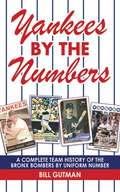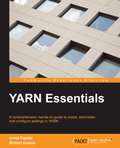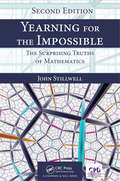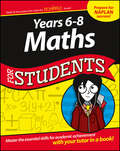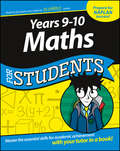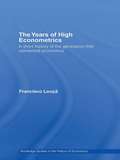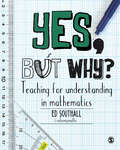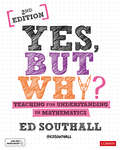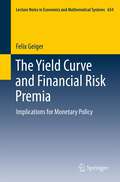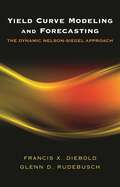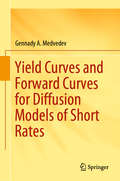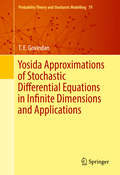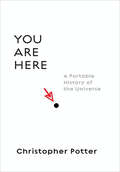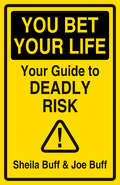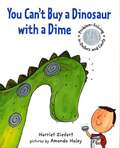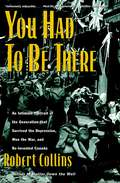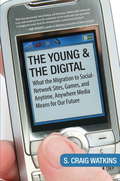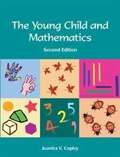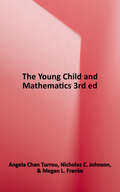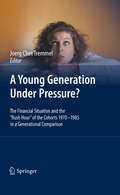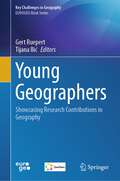- Table View
- List View
Yankees by the Numbers: A Complete Team History of the Bronx Bombers by Uniform Number
by Bill GutmanWhat do Mark Koenig, Red Rolfe, Frank Crosetti, Sandy Alomar, Bobby Murcer, Wayne Tolleson, and Derek Jeter all have in common? They all wore #2 for the New York Yankees, even though nearly eight decades have passed between the first time Koenig buttoned up a Yankee uniform with that number and the last time Jeter performed the same routine. Since 1929, the Yankees have issued 73 different numbers to more than 1,500 players. That’s a lot of overlap. That also makes for a lot of good stories. Yankees by the Numbers tells those stories for every Yankee since ’29-from Earle Combs (the original #1) to Charlie Keller (the only Yankee to ever wear #99)-providing insightful and humorous commentary about the more memorable players, from a fan’s perspective. Complete with more than 100 baseball cards (courtesy of the Topps Company), each chapter also features a fascinating sidebar that reveals which players were the most obscure to wear a certain number, and also which numbers produced the most wins, home runs and stolen bases in club history. For data seekers, the Yankees Alphabetical Roster is a complete listing of every single Yankee since 1929, the numbers they wore, and their years of service at the House that Ruth Built.
YARN Essentials
by Amol Fasale Nirmal KumarIf you have a working knowledge of Hadoop 1.x but want to start afresh with YARN, this book is ideal for you. You will be able to install and administer a YARN cluster and also discover the configuration settings to fine-tune your cluster both in terms of performance and scalability. This book will help you develop, deploy, and run multiple applications/frameworks on the same shared YARN cluster.
Yearning for the Impossible: The Surprising Truths of Mathematics, Second Edition
by John StillwellYearning for the Impossible: The Surprising Truth of Mathematics, Second Edition explores the history of mathematics from the perspective of the creative tension between common sense and the "impossible" as the author follows the discovery or invention of new concepts that have marked mathematical progress. The author puts these creations into a broader context involving related "impossibilities" from art, literature, philosophy, and physics. This new edition contains many new exercises and commentaries, clearly discussing a wide range of challenging subjects.
Years 6-8 Maths For Students
by Consumer DummiesYour tutor in a book! Master the essential mathematical skills for success! 'I don't know how to do this' is a refrain heard whilst many a student is doing homework. Parents are increasingly called on for assistance, but are themselves struggling to help their children. Years 6-8 Maths For Students is a reference guide for both students and parents, aiming to fill the gaps in a student's knowledge base, build confidence and reduce stress. Written with the same friendly, how-to approach of the successful For Dummies books, this new educational reference will empower students and develop their mathematical skills for exams, NAPLAN testing and, most importantly, life beyond secondary school. With worries that students are being taught to pass tests at the expense of understanding -- this guide will help students cement their mathematical foundations. Grasp the nuts and bolts of numbers, algebra, geometry and measurement Helps students with maths as they transition from primary to secondary school Complete homework and prepare for tests with confidence Save money on expensive tutors. Years 6-8 Maths For Students empowers students to improve their educational outcomes.
Years 9-10 Maths For Students
by Consumer DummiesYour tutor in a book! Master the essential mathematical skills for success! 'I don't know how to do this' is a refrain heard whilst many a student is doing homework. Parents are increasingly called on for assistance, but are themselves struggling to help their children. Years 9-10 Maths For Students is a reference guide for both students and parents, aiming to fill the gaps in a student's knowledge base, build confidence and reduce stress. Written with the same friendly, how-to approach of the successful For Dummies books, this new educational reference will empower students and develop their mathematical skills for exams, NAPLAN testing and, most importantly, life beyond secondary school. With worries that students are being taught to pass tests at the expense of understanding -- this guide will help students cement their mathematical foundations. Grasp the nuts and bolts of numbers, algebra, geometry and measurement. Master simple to complex maths questions, including worded problems Complete homework and prepare for tests with confidence Save money on expensive tutors. Years 9-10 Maths For Students empowers students to improve their educational outcomes.
The Years of High Econometrics: A Short History of the Generation that Reinvented Economics (Routledge Studies in the History of Economics)
by Francisco LouçãA fascinating and comprehensive history, this book explores the most important transformation in twentieth century economics: the creation of econometrics. Containing fresh archival material that has not been published before and taking Ragnar Frisch as the narrator, Francisco Louca discusses both the keys events - the establishment of the Econometric Society, the Cowles Commission and the journal Econometrica – and the major players - economists like Wesley Mitchell, mathematicians like John von Neumann and statisticians like Karl Pearson - in history that shaped the development of econometrics. He discusses the evolution of their thought, detailing the debates, the quarrels and the interrogations that crystallized their work and even offers a conclusion of sorts, suggesting that some of the more influential thinkers abandoned econometrics or became critical of its development. International in scope and appeal, The Years of High Econometrics is an excellent accompaniment for students taking courses on probability, econometric methods and the history of economic thought.
Yes, but why? Teaching for understanding in mathematics
by Ed SouthallGetting the right answers in maths is only half the problem. Understanding why what you’re doing works is the part that often stumps students and teachers alike. Does maths feels like a collection of random rules and steps that somehow lead you to an answer? Don’t worry you’re not alone. Ask yourself: why do we have odd and even numbers? Why do two negative numbers multiply to make a positive? Why do fraction operations work? What is cosine and where does it come from? Yes, but why? answers all of your questions, and sheds light on the hidden connections between everything in mathematics at school. Maths makes sense. It always has, but until now maybe no-one ever showed you. A must-read for those training to teach primary or secondary mathematics via university-based (PGCE, BEd, BA w/QTS) or school-based (School Direct, SCITT, Teach First) routes and current teachers wishing to deepen their mathematical understanding. FIND OUT MORE ABOUT THE AUTHOR BEHIND THE BOOK WITH OUR SPECIAL FEATURE: 60 Seconds with Ed Southall
Yes, but why? Teaching for understanding in mathematics
by Ed SouthallGetting the right answers in maths is only half the problem. Understanding why what you’re doing works is the part that often stumps students and teachers alike. Does maths feels like a collection of random rules and steps that somehow lead you to an answer? Don’t worry you’re not alone. Ask yourself: why do we have odd and even numbers? Why do two negative numbers multiply to make a positive? Why do fraction operations work? What is cosine and where does it come from? Yes, but why? answers all of your questions, and sheds light on the hidden connections between everything in mathematics at school. Maths makes sense. It always has, but until now maybe no-one ever showed you. A must-read for those training to teach primary or secondary mathematics via university-based (PGCE, BEd, BA w/QTS) or school-based (School Direct, SCITT, Teach First) routes and current teachers wishing to deepen their mathematical understanding. FIND OUT MORE ABOUT THE AUTHOR BEHIND THE BOOK WITH OUR SPECIAL FEATURE: 60 Seconds with Ed Southall
Yes, but why? Teaching for understanding in mathematics (Corwin Ltd)
by Ed SouthallGetting the right answers in maths is only half the problem. Understanding why what you’re doing works is the part that often stumps students and teachers alike. The essential guide for mathematics teachers and those training to teach, Yes, but why? answers all your questions, and sheds light on the hidden connections between everything in mathematics at school. This second edition includes: · A new ‘Test yourself’ feature in every chapter · More coverage of the four operations · Enhanced discussion of fractions and proportionality · Downloadable figures for use in the classroom
Yes, but why? Teaching for understanding in mathematics (Corwin Ltd)
by Ed SouthallGetting the right answers in maths is only half the problem. Understanding why what you’re doing works is the part that often stumps students and teachers alike. The essential guide for mathematics teachers and those training to teach, Yes, but why? answers all your questions, and sheds light on the hidden connections between everything in mathematics at school. This second edition includes: · A new ‘Test yourself’ feature in every chapter · More coverage of the four operations · Enhanced discussion of fractions and proportionality · Downloadable figures for use in the classroom
Yet Another Introduction to Analysis
by Victor BryantMathematics education in schools has seen a revolution in recent years. In this book, the author steers a simple and well-motivated path through the central ideas of real analysis. Each concept is introduced only after its need has become clear and after it has already been used informally.
The Yield Curve and Financial Risk Premia: Implications for Monetary Policy
by Felix GeigerThe determinants of yield curve dynamics have been thoroughly discussed in finance models. However, little can be said about the macroeconomic factors behind the movements of short- and long-term interest rates as well as the risk compensation demanded by financial investors. By taking on a macro-finance perspective, the book's approach explicitly acknowledges the close feedback between monetary policy, the macroeconomy and financial conditions. Both theoretical and empirical models are applied in order to get a profound understanding of the interlinkages between economic activity, the conduct of monetary policy and the underlying macroeconomic factors of bond price movements. Moreover, the book identifies a broad risk-taking channel of monetary transmission which allows a reassessment of the role of financial constraints; it enables policy makers to develop new guidelines for monetary policy and for financial supervision of how to cope with evolving financial imbalances.
The Yield Curve and Financial Risk Premia: Implications for Monetary Policy (Lecture Notes in Economics and Mathematical Systems #654)
by Felix GeigerThe determinants of yield curve dynamics have been thoroughly discussed in finance models. However, little can be said about the macroeconomic factors behind the movements of short- and long-term interest rates as well as the risk compensation demanded by financial investors. By taking on a macro-finance perspective, the book’s approach explicitly acknowledges the close feedback between monetary policy, the macroeconomy and financial conditions. Both theoretical and empirical models are applied in order to get a profound understanding of the interlinkages between economic activity, the conduct of monetary policy and the underlying macroeconomic factors of bond price movements. Moreover, the book identifies a broad risk-taking channel of monetary transmission which allows a reassessment of the role of financial constraints; it enables policy makers to develop new guidelines for monetary policy and for financial supervision of how to cope with evolving financial imbalances.
Yield Curve Modeling and Forecasting: The Dynamic Nelson-Siegel Approach (The Econometric and Tinbergen Institutes Lectures)
by Francis X. Diebold Glenn D. RudebuschUnderstanding the dynamic evolution of the yield curve is critical to many financial tasks, including pricing financial assets and their derivatives, managing financial risk, allocating portfolios, structuring fiscal debt, conducting monetary policy, and valuing capital goods. Unfortunately, most yield curve models tend to be theoretically rigorous but empirically disappointing, or empirically successful but theoretically lacking. In this book, Francis Diebold and Glenn Rudebusch propose two extensions of the classic yield curve model of Nelson and Siegel that are both theoretically rigorous and empirically successful. The first extension is the dynamic Nelson-Siegel model (DNS), while the second takes this dynamic version and makes it arbitrage-free (AFNS). Diebold and Rudebusch show how these two models are just slightly different implementations of a single unified approach to dynamic yield curve modeling and forecasting. They emphasize both descriptive and efficient-markets aspects, they pay special attention to the links between the yield curve and macroeconomic fundamentals, and they show why DNS and AFNS are likely to remain of lasting appeal even as alternative arbitrage-free models are developed. Based on the Econometric and Tinbergen Institutes Lectures, Yield Curve Modeling and Forecasting contains essential tools with enhanced utility for academics, central banks, governments, and industry.
Yield Curves and Forward Curves for Diffusion Models of Short Rates
by Gennady A. MedvedevThis book is dedicated to the study of the term structures of the yields of zero-coupon bonds. The methods it describes differ from those usually found in the literature in that the time variable is not the term to maturity but the interest rate duration, or another convenient non-linear transformation of terms. This makes it possible to consider yield curves not only for a limited interval of term values, but also for the entire positive semiaxis of terms. The main focus is the comparative analysis of yield curves and forward curves and the analytical study of their features. Generalizations of yield term structures are studied where the dimension of the state space of the financial market is increased. In cases where the analytical approach is too cumbersome, or impossible, numerical techniques are used. This book will be of interest to financial analysts, financial market researchers, graduate students and PhD students.
Yosida Approximations of Stochastic Differential Equations in Infinite Dimensions and Applications
by T. E. GovindanThis research monograph brings together, for the first time, the varied literature on Yosida approximations of stochastic differential equations (SDEs) in infinite dimensions and their applications into a single cohesive work. The author provides a clear and systematic introduction to the Yosida approximation method and justifies its power by presenting its applications in some practical topics such as stochastic stability and stochastic optimal control. The theory assimilated spans more than 35 years of mathematics, but is developed slowly and methodically in digestible pieces. The book begins with a motivational chapter that introduces the reader to several different models that play recurring roles throughout the book as the theory is unfolded, and invites readers from different disciplines to see immediately that the effort required to work through the theory that follows is worthwhile. From there, the author presents the necessary prerequisite material, and then launches the reader into the main discussion of the monograph, namely, Yosida approximations of SDEs, Yosida approximations of SDEs with Poisson jumps, and their applications. Most of the results considered in the main chapters appear for the first time in a book form, and contain illustrative examples on stochastic partial differential equations. The key steps are included in all proofs, especially the various estimates, which help the reader to get a true feel for the theory of Yosida approximations and their use. This work is intended for researchers and graduate students in mathematics specializing in probability theory and will appeal to numerical analysts, engineers, physicists and practitioners in finance who want to apply the theory of stochastic evolution equations. Since the approach is based mainly in semigroup theory, it is amenable to a wide audience including non-specialists in stochastic processes.
You Are Here: A Portable History of the Universe
by Christopher Potter“You Are Here is not just physics for poets, but as close to poetry or music as science is ever likely to get. Christopher Potter’s narrative is as imaginative, ingenious, and elegantly concise as it is user-friendly.” — Sylvia Nasar, author of A Beautiful Mind“A personal, brilliant, and often amusing account . . . . An idiosyncratic, encyclopedic blitzkrieg of a book.” —The Boston Globe“The Verdict: Read.” — TimeChristopher Potter’s You Are Here is a lively and accessible biography of the universe—how it fits together and how we fit into it—in the style of science writers like Richard Dawkins, Bill Bryson, and Richard Feynman, as seen through the lens of today’s most cutting-edge scientific thinking.
You Bet Your Life: Your Guide to Deadly Risk
by Sheila Buff Joe BuffThe gritty and granular truth behind the wagers we make with our lives every single day—and, if we’re unlucky, just once in a lifetime. What are your chances of living through the next 24 hours? This week? This month? This decade? Will your job kill you? Your car kill you? Your spouse kill you? Will your own bad habits kill you? Or will a rogue asteroid just kill us all? Each time you lay your head on the pillow at night or set your feet on the floor come morning, you bet your life. Exactly what odds do you face 24/7? You Bet Your Life applies to you, the individual, the analytical approach insurance companies use to calculate risk: actuarial science. The result is a comprehensive, encyclopedic, real world assessment of more than 1,000 of the risks we take every day of our all-too-finite lives, from boarding an airplane to tempting a shark attack by dipping a toe in the ocean. You Bet Your Life is introduced by an authoritative essay explaining how professional actuaries calculate risk and how less objective entities—in government, finance, science, technology, and religion—apply their own competing calculi of risk and reward.
You Can't Buy A Dinosaur With A Dime
by Harriet Ziefert Amanda HaleyClink, clink, clink, clink...Clink, clink, clinkity... Money saved in a bank makes your brain think-thinkity! <P><P>Children are fascinated by money how it looks, feels, smells, and most of all, what it buys. And Pete is no exception. The rhymed verse describes how Pete saves his allowance, spends too much of it, has second thoughts, and starts over. <P><P>Young readers will not only applaud Pete's decisions, but join him in his computations as he saves, spends, and strategizes over future purchases. The lively combination of fact and fiction, plus humorous art, will prove both thought-provoking and thoroughly enjoyable.
You Had to Be There
by Robert CollinsThey gained their maturity in an age of monumental and unprecedented change – from horse-and-buggy, Model TFord, and crank telephone, to moonwalks, space shuttles, and the Internet. They are better educated, more affluent, more vigorous, and longer-lived than any generation before them, yet obstinately cling to a forthright simplicity no generation is likely to regain. They are proudly “old fashioned” in their outlook, hardworking, and frugal in their ways. They are the last enthusiastic patriots, the last to accept authority with respect. They are the last generation to have reached adulthood without television, credit cards, computers, or the Pill. Their younger critics may call them “old fogies”; Robert Collins calls them Generation M, formature. InYou Had to Be There, Robert Collins gives us the entire history of this extraordinary and hugely influential generation. Through this fascinating story he weaves the voices of Canadians from across the country, who speak with humour, regret, and passion about the hardships and triumphs of their lives and about the widening gap between themselves and the rest of Canada. Generation gaps are as old as humankind, but rarely has there been as much misunderstanding and veiled animosity as there is between young and old today. Robert Collins accounts for the prejudices, pokes fun at the rivalries, and, with humour and sympathy, invites younger Canadians to re-examine their parents’ or grandparents’ lives and consider, maybe for the first time, the true proportion of their legacy.
The Young and the Digital
by S. Craig WatkinsIn The Young and the Digital, S. Craig Watkins skillfully draws from more than 500 surveys and 350 in-depth interviews with young people, parents, and educators to understand how a digital lifestyle is affecting the ways youth learn, play, bond, and communicate. Timely and deeply relevant, the book covers the influence of MySpace and Facebook, the growing appetite for "anytime, anywhere" media and "fast entertainment," how online "digital gates" reinforce race and class divisions, and how technology is transforming America's classrooms. Watkins also debunks popular myths surrounding cyberpredators, Internet addiction, and social isolation. The result is a fascinating portrait, both celebratory and wary, about the coming of age of the first fully wired generation. From the Trade Paperback edition.
The Young Child And Mathematics (Second Edition)
by Juanita V. CopleyReflects recent developments in math education using vignettes from classrooms, activity ideas, and strategies for teaching young children about math processes and concepts. Incorporates standards and guidelines from NCTM and NAEYC.
The Young Child and Mathematics, Third Edition
by Angela Chan Turrou Nicholas C. Johnson Megan L. FrankeTap into the Power of Child-Led Math Teaching and Learning Winner of the 2022 Excel Silver Award for Technical Book. Everything a child does has mathematical value—these words are at the heart of this completely revised and updated third edition of The Young Child and Mathematics. Grounded in current research, this classic book focuses on how teachers working with children ages 3 to 6 can find and build on the math inherent in children's ideas in ways that are playful and intentional. This resource - Illustrates through detailed vignettes how math concepts can be explored in planned learning experiences as well as informal spaces - Highlights in-the-moment instructional decision-making and child-teacher interactions that meaningfully and dynamically support children in making math connections - Provides an overview of what children know about counting and operations, spatial relations, measurement and data, and patterns and algebra - Offers examples of informal documentation and assessment approaches that are embedded within classroom practice Deepen your understanding of how math is an integral part of your classroom all day, every day.
A Young Generation Under Pressure?: The Financial Situation and the "Rush Hour" of the Cohorts 1970 - 1985 in a Generational Comparison
by Joerg TremmelJustice between generations is still not as prominent on any agenda as justice between rich and poor or men and women. For the first time, this three-part book explores the situation of young people of today in comparison to their direct predecessors. The first part, The Financial Situation of the Young Generation in a Generational Comparison, deals with this generation's financial standing; the second part, The Rush Hour of Life, examines their time restrictions. Both are considered from a life-course perspective. The third part, On the Path to Gerontocracy?, addresses the demographic shift in favor of the elderly in aging Western democracies.
Young Geographers: Showcasing Research Contributions in Geography (Key Challenges in Geography)
by Gert Ruepert Tijana IlićThis book shows an updated overview of research about human geography topics like urban growth/urban challenges, transportation, landscape, land cover, geospatial analysis, regional planning/local development, cultural geography, tourism, and so on. Between 2020 and 2022, due to COVID-19 and lockdowns worldwide, there were fewer opportunities for young and upcoming researchers to present their state-of-the-art findings at conferences. In order to highlight exceptional research of young geographers during this time, the idea for this book was created. In collaboration with the EGEA alumni foundation for students and young geographers, 12 authors were selected to showcase their scientific work. In addition to that, most of them present amazing maps and figures as outstanding expression of the need of GIS for geography research.
